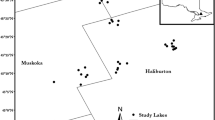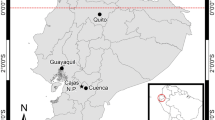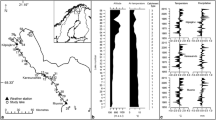Abstract
An increase in the frequency and intensity of marine storm surges is a predicted consequence of climate warming, and therefore it is important to better understand the biological responses to such events in coastal regions. In late September 1999, a major storm surge resulted in a saltwater intrusion event over a large area of the Mackenzie Delta (NT, Canada) front, causing rapid salinization of lakes on the alluvial plain. Due to a lack of long-term ecological monitoring data in the region, the impacts that the saltwater intrusion event had on the biota of affected lakes were unknown. We used high-resolution paleolimnological approaches to reconstruct past assemblage changes in Cladocera from impacted Lake DZO-29 (unofficial name) in order to determine how different cladoceran species responded to a major increase in lake salinity following the 1999 storm surge. Camptocercus were extirpated from the lake following the saltwater intrusion and have not recovered. We also observed an initial decrease in Alona relative abundance following the marine flooding, likely reflecting a loss of A. quadrangularis, A. barbulata, and A. costata from the lake. A. circumfimbriata, Chydorus biovatus, C. brevilabris, and Bosmina spp. were abundant both before and after the saltwater intrusion, and Paralona pigra was present following the storm surge, but not prior to it. The most notable shift in Cladocera in the recent sedimentary record, however, occurred much earlier, with an increase in pelagic Bosmina taxa and a subsequent decrease in the benthic/littoral taxa Chydorus and Camptocercus, an assemblage shift that is consistent with a response to climate warming in this region, and strongly correlated to other changes in the lake inferred to be as a result of regional warming.


Similar content being viewed by others
References
Achuthankutty CT, Shrivastava Y, Mahambre GG, Goswami SC, Madhupratap M (2000) Parthenogenetic reproduction of Diaphanosoma celebensis (Crustacea: Cladocera): influence of salinity on feeding, survival, growth and neonate production. Mar Biol 137:19–22
Amsinck SL, Jeppesen E, Landkildehus F (2005) Inference of past changes in zooplankton community structure and planktivorous fish abundance from sedimentary subfossils—a study of a coastal lake subjected to major fish kill incidents during the past century. Arch Hydrobiol 162:363–382
Appleby PG (2001) Chronostratigraphic techniques in recent sediments. In: Last WM, Smol JP (eds) Tracking environmental changes using lake sediments. Vol 1: basin analysis, coring and chronological techniques. Kluwer, Dordrecht
Battarbee RW, Jones VJ, Flower RJ, Cameron NG, Bennion H, Carvalho L, Juggins S (2001) Diatoms. In: Smol JP, Birks HJB, Last WM (eds) Tracking environmental change using lake sediments. Vol 3: terrestrial, algal and siliceous indicators. Kluwer, Dordrecht
Bégin C, Michaud Y, Archambault S (2000) Tree-ring evidence of recent climate changes in the Mackenzie Basin, Northwest Territories. In: Dyke LD, Brooks GR (eds) The physical environment of the Mackenzie Valley, Northwest Territories: a base line for the assessment of environmental change. Geological Survey of Canada, Ottawa
Bennett K (1996) Determination of the number of zones in a biostratigraphic sequence. New Phytol 132:155–170
Bos DG, Cumming BF (2003) Sedimentary Cladoceran remains and their relationship to nutrients and other limnological variables in 53 lakes from British Columbia, Canada. Can J Fish Aquat Sci 60:1177–1189
Bos DG, Cumming BF, Smol JP (1999) Cladocera and Anostraca from the Interior Plateau of British Columbia Canada, as paleolimnological indicators of salinity and lake level. Hydrobiologia 392:129–141
Bowman TE, Abele LG (1982) Classification of the recent Crustacea. In: Abele LG (ed) Systematics, the fossil record, and biogeography. Academic Press, New York, NY, pp 1–27
Burn CR, Kokelj SV (2009) The environment and permafrost of the Mackenzie Delta area. Permafrost Periglacial Process 20:83–105
Chengalath R (1982) A faunistic and ecological survey of littoral Cladocera of Canada. Can J Zool 60:2668–2682
Dole-Olivier MJ, Galassi DMP, Marmonier P, Creuzé des Châtelliers M (2000) The biology and ecology of lotic microcrustaceans. Freshw Biol 44:63–91
Frey DG (1980) On the plurality of Chydorus sphaericus (O. F. Müller) (Cladocera, Chydoridae), and designation of a neotype from SjaelsØ Denmark. Hydrobiologia 69:83–123
Frey DG (1993) The penetration of Cladocera into saline waters. Hydrobiologia 267:233–248
Glew J (1988) A portable extruding device for close interval sectioning of unconsolidated core samples. J Paleolimnol 1:235–239
Glew J (1989) A new trigger mechanism for sediment samplers. J Paleolimnol 2:241–243
Grimm EC (1987) CONISS—a FORTRAN-77 program for stratigraphically constrained cluster-analysis by the method of incremental sum of squares. Comput Geosci 13:13–35
Grimm EC (2004) Tilia and Tilia graph computer programs version 2.0.2. Illinois State Museum Research and Collections Center, Springfield, IL
Hammer UT, Forró L (1992) Zooplankton distribution and abundance in the saline lakes of British Columbia, Canada. Int J Salt Lake Res 1:65–80
Heiri O (2004) Within-lake variability of subfossil chironomid assemblages in shallow Norwegian lakes. J Paleolimnol 32:67–84
Jeppesen E, Noges P, Davidson TA, Haberman J, Noges T, Blank K, Lauridsen TL, Martin Søndergaard M, Sayer C, Laugaste R, Johansson LS, Bjerring R, Amsinck SL (2011) Zooplankton as indicators in lakes: a scientific-based plea for including zooplankton in the ecological quality assessment of lakes according to the European Water Framework Directive (WFD). Hydrobiologia 676:279–297
Juggins S (2009) Rioja: analysis of Quaternary science data, R package version 0.5-6. http://cran.r-project.org/package=rioja
Kattel GR, Battarbee RW, Mackay A, Birks HJB (2007) Are cladoceran fossils in lake sediment samples a biased reflection of the communities from which they are derived? J Paleolimnol 38:157–181
Kokelj SV, Lantz TC, Solomon S, Pisaric MFJ, Keith D, Morse P, Thienpont JR, Smol JP, Esagok D (in press) Utilizing multiple sources of knowledge to investigate northern environmental change: regional ecological impacts of a storm surge in the outer Mackenzie Delta, N.W.T. Arctic
Korhola A, Rautio M (2001) Cladocera and other brachiopod crustaceans. In: Smol JP, Birks HJB, Last WM (eds) Tracking environmental change using lake sediments 4: zoological indicators. Kluwer, Dordrecht, pp 5–41
Kurek J, Korosi JB, Jeziorski A, Smol JP (2010) Establishing reliable minimum count sizes for cladoceran microfossils sampled from lake sediments. J Paleolimnol 44:603–612
Lantz TC, Kokelj SV (2008) Increasing rates of retrogressive thaw slump activity in the Mackenzie Delta region, N.W.T., Canada. Geophys Res Lett 35:L06502
Mackay JR (1963) The Mackenzie Delta area, N.W.T. Geographical Branch Memoir 8. Department of Mines and Technical Surveys, Ottawa
Manson GK, Solomon SM (2007) Past and future forcing of Beaufort Sea coastal change. Atmos Ocean 45:107–122
Martínez-Jerónimo F, Martínez-Jerónimo L (2007) Chronic effect of NaCl salinity on a freshwater strain of Daphnia magna Straus (Crustacea: Cladocera): a demographic study. Ecotox Environ Safe 63:411–416
Michelutti N, Wolfe AP, Vinebrooke RD, Rivard B, Briner JP (2005) Recent primary production increases in arctic lakes. Geophys Res Lett 32:3–6
Michelutti N, Blais JM, Cumming BF, Paterson AM, Rühland K, Wolfe AP, Smol JP (2010) Do spectrally-inferred determinations of chlorophyll a reflect trends in lake trophic status? J Paleolimnol 43:205–217
Oksanen J, Blanchet FG, Kindt R, Legendre P, O’Hara RB, Simpson GL, Solymos P, MHH Stevens, Wagner H (2010) Vegan: community ecology package. R package version 1.17-4. http://CRAN.R-project.org/package=vegan
Paterson M (1993) The distribution of microcrustacea in the littoral zone of a freshwater lake. Hydrobiologia 263:173–183
Pisaric MFJ, Thienpont JR, Kokelj SV, Nesbitt H, Lantz TC, Solomon S, Smol JP (2011) Impacts of a recent storm surge on an Arctic delta ecosystem examined in the context of the last millennium. Proc Natl Acad Sci 108:8960–8965
R Development Core Team (2011) R: a language and environment for statistical computing. R Foundation for Statistical Computing, Vienna. http://www.R-project.org/
Rampton VN (1988) Quaternary geology of the Tuktoyaktuk coastlands, Northwest Territories. Geological Survey of Canada, Memoir 423. pp. 8
Sarmaja-Korjonen K (2002) Multi-proxy data from Kaksoislammi Lake in Finland: dramatic changes in the late Holocene cladoceran assemblages. J Paleolimnol 28:287–296
Sarmaja-Korjonen K, Hyvärinen H (2002) Subfossil littoral Cladocera as indicators of brackish-water Littorina transgression of the Baltic Basin in a small lake in Finland. Boreas 31:356–361
Schelske CL, Peplow A, Brenner M, Spencer CN (1994) Low-background gamma counting: applications for 210Pb dating of sediments. J Paleolimnol 10:115–128
Smirnov NN (1998) A revision of the genus Camptocercus (Anomopoda, Chydoridae, Aloninae). Hydrobiologia 386:63–83
Smol JP (2008) Pollution of Lakes and Rivers: a paleoenvironmental perspective, 2nd edn. Wiley-Blackwell, Oxford
Smol JP, Douglas MSV (2007) From controversy to consensus: making the case for recent climatic change in the Arctic using lake sediments. Front Ecol Environ 5:466–474
Sweetman JN, Smol JP (2006a) Patterns in the distribution of cladocerans (Crustacea: Branchiopoda) in lakes across a north-south transect in Alaska, USA. Hydrobiologia 553:277–291
Sweetman JN, Smol JP (2006b) A guide to the identification of cladoceran remains (Crustacea: Branchiopoda) in Alaskan lake sediments. Arch Hydrobiol Suppl 151:353–394
Sweetman JN, LaFace E, Rühland KM, Smol JP (2008) Evaluating the response of Cladocera to recent environmental change in lakes from the Canadian Arctic treeline region. Arct Antarct Alp Res 40:584–591
Sweetman JN, Rühland KM, Smol JP (2010) Environmental and spatial factors influencing the distribution of cladocerans in lakes across the central Canadian Arctic treeline region. J Limnol 69:76–87
Szeroczyńska K, Sarmaja-Korjonen K (2007) Atlas of subfossil Cladocera from central and northern Europe. Friends of the Lower Vistula Society, Świecie
ter Braak CJF, Šmilauer P (2002) CANOCO reference manual and CANODRAW for WINDOWS users guide: software for canonical community ordination (version 4.5). Microcomputer Power, Ithaca, NY
Weider LJ, Hebert PDN (1987) Ecological and physiological differentiation among low-Arctic clones of Daphnia pulex. Ecology 68:188–198
Acknowledgments
We thank the Polar Continental Shelf Program for logistical and financial support. This study was also funded by the Natural Sciences and Engineering Research Council (NSERC) of Canada through Discovery and Northern Supplement research grants to MFJP and JPS, and Aboriginal Affairs and Northern Development through the Cumulative Impact Monitoring Program (CIMP) and Northern Scientific Training Program (NSTP) grants to JRT. We thank Steve Brooks and two anonymous reviewers for providing comments, which greatly improved the quality of the manuscript.
Author information
Authors and Affiliations
Corresponding author
Rights and permissions
About this article
Cite this article
Deasley, K., Korosi, J.B., Thienpont, J.R. et al. Investigating the response of Cladocera to a major saltwater intrusion event in an Arctic lake from the outer Mackenzie Delta (NT, Canada). J Paleolimnol 48, 287–296 (2012). https://doi.org/10.1007/s10933-012-9577-6
Received:
Accepted:
Published:
Issue Date:
DOI: https://doi.org/10.1007/s10933-012-9577-6




